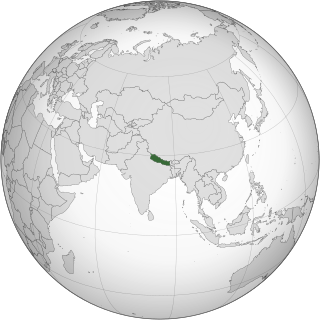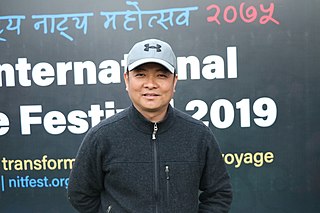Related Research Articles

Kathmandu, officially Kathmandu Metropolitan City, is the capital and most populous city of Nepal with 845,767 inhabitants living in 105,649 households in 2021 and 2.9 million people in its urban agglomeration. It is located in the Kathmandu Valley, a large valley in the high plateaus in central Nepal, at an altitude of 1,400 metres.

The current population of Nepal is 29,192,480 as per the 2021 census. The population growth rate is 0.93% per year.

Nepali Cinema, also referred to as "Nepali Chalachitra" in Nepali, is the filmmaking industry in Nepal. This includes films in various languages of Nepal, most notably in Nepali, Maithili and Bhojpuri. The term Kollywood is also used, as a portmanteau for films produced in the Nepali language while the Nepalese films produced from Kathmandu and Janakpur in the Maithili language is known as Mithilawood. Both of these film industries are the largest viewing cinema of Nepal and are collectively known as Kollywood.

The Tamang, are a Tibeto-Burmese ethnic group of Nepal, Southern Bhutan and North India. In Nepal Tamang/Moormi people constitute 5.6% of the Nepalese population at over 1.3 million in 2001, increasing to 1,539,830 as of the 2011 census. Tamang people are concentrated in the central hilly region of Nepal. Indian Tamangs are found in significant numbers in the state of Sikkim and districts of Darjeeling and Kalimpong in West Bengal state. Bhutanese Tamangs are native to various districts in the southern foothills of the Kingdom of Bhutan. Such districts include the Tsirang District, the Dagana District, the Samtse District, the Chukha District, the Sarpang District and the Samdrup Jongkhar District. Tamang language is the fifth most-spoken language in Nepal.

Religion in Nepal encompasses a wide diversity of groups and beliefs. Nepal is a secular nation and secularism in Nepal under the interim constitution is defined as 'religious, cultural freedom, along with the protection of religion, culture handed down from time immemorial that is "the state government is bound for protecting and fostering Hindu religion" while maintaining "religious" and "cultural" freedom throughout the nation as fundamental rights. Nepal's most widely practiced religions are Hinduism and Buddhism, which account for 81.3% and 9.04% of the national population respectively. According to a survey, Nepal is the most religious Hindu-majority country in the world, with most of the important Hindu pilgrimage centers concentrated in this country. Nepal is also the birthplace of Siddhartha Gautama, because of which Buddhism has a very special place in the country and is often intertwined with Hinduism among some communities. Nepal is a multi-cultural, multi-ethnic, multi-lingual and multi-religious nation through democracy. Shiva is widely regarded as the guardian deity of Nepal. Nepal is home to the world-famous Pashupatinath Temple, a UNESCO World Heritage Site where Hindus from around the world come for pilgrimage purposes. According to Hindu Itihasa, the goddess Sita of the epic Ramayana was born in the Mithila Kingdom of King Janaka Raja. The national animal of Nepal is the cow, which is considered a sacred animal in Hinduism. Because of this, the slaughter of cows is illegal in Nepal.

Ethnic groups in Nepal are delineated using language, ethnic identity or the caste system in Nepal. They are categorized by common culture and endogamy. Endogamy carves out ethnic groups in Nepal.

Languages of Nepal constitutionally called Nepalese languages are the languages having at least an ancient history or origin inside the sovereign territory of Nepal spoken by Nepalis. The 2011 national census lists 123 languages spoken as a mother tongue in Nepal. Most belong to the Indo-Aryan and Sino-Tibetan language families.

In 2007 Nepal repealed the laws against gay sex and introduced several laws which explicitly protected sexual orientation. The Nepalese Constitution now recognizes LGBT rights as fundamental rights. Based on a ruling of the Supreme Court of Nepal in late 2007, the government was also considering the legalization of same-sex marriage. According to several sources, the Constitution of 2015 was expected to include it. Although the Constitution explicitly says that "marginalized" communities are to be granted equal rights under the law, and that Nepal's LGBT people fall into this category, it does not explicitly address the legalization of same-sex marriage.

Sushma Joshi is a Nepali writer, filmmaker based in Kathmandu, Nepal. Her fiction and non-fiction deal with Nepal's civil conflict, as well as stories of globalization, migration and diaspora.

The Kulung Rai also call Kulunge Rai/Rodu are one of the major subgroup of Rai people and indigenous communities of Nepal, as well as parts of northeastern Sikkim and Darjeeling district of India, having their own Kulung language, culture, history and tradition. The Kulung population in Nepal is estimated to be in the region of 150,000-200,000.

Lokta paper, also known as Nepali kagaj or Nepali paper, is a wildcrafted, handmade artisan paper indigenous to Nepal. It is made from the bark of two of the species of the shrub Daphne. The paper was used historically in Nepal for religious scriptures and government documents. In modern day, the paper is used to make notebooks, religious scriptures, arts, painting canvas and for some of the government documents.
Tsering Rhitar Sherpa is a Nepalese filmmaker, screenwriter, and film producer. His first film, Mukundo: Mask of Desire, was Nepal's official entry for Oscars.

China Harayeko Manchhe is an autobiography written by Hari Bansha Acharya. The story features a god-fearing man who happens to lose his "China" or "Cheena" (horoscope).
Santali cinema also known as Sollywood, has its presence in the Indian states of Jharkhand, West Bengal, Assam, Orissa, and parts of Nepal, where Santals live. Santali films are made in the Santali language.

Ministry of Federal Affairs and General Administration, (MoFAGA), is the ministry of Nepal that supervises activities undertaken by local governments in Nepal. It also regulates and manages the civil service.

Dayahang Rai is a Nepali actor, director, and playwright. Dayahang is known for his uniqueness in Nepali cinema. He is one of the most popular and acclaimed actors of Nepal. He has starred in over 40 films and is one of the leading contemporary actors of Nepal. He has received various accolades throughout his acting career. Dayahang is a veteran theatrical actor who made the jump to Nepali cinemas.
The National Film Awards is the most prominent and prestigious award of Nepali cinema. The first National Film Award was held in 2005, in the presence of His Majesty's King Gyanendra Bir Bikram Shah. The event is held at the residence of the president of Nepal and the president gives the awards to the winners in various categories. It is yearly organised by Film Development Board, Nepal.
References
- ↑ "Indigenous Film Archive". Ifanepal.org.np. Archived from the original on 2013-08-15. Retrieved 2013-08-18.